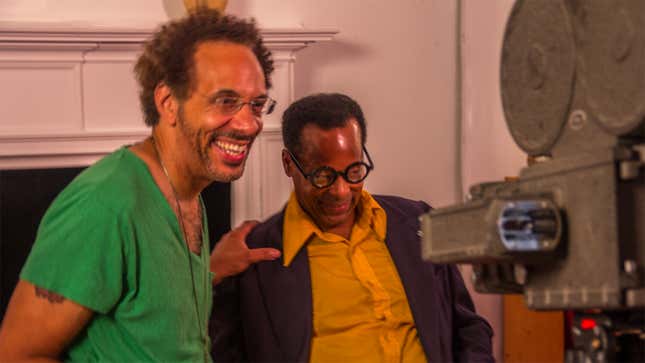Director Stephen Winter Has Been Ahead of the Curve; The Curve Is Finally Catching Up
The Black queer filmmaker discusses two of his revolutionary movies, which are now streaming
EntertainmentMovies

“Energy, more activity, more and more story, more character, more jokes, more to look at, more to feel,” is how filmmaker Stephen Winter described his sensibility in a recent conversation with Jezebel. The occasion for our chat was the Criterion Channel’s recent addition of Winter’s two features—1996’s Chocolate Babies and 2015’s Jason and Shirley—to its roster. The kind of institutional co-signing from a respected brand has often eluded Winter’s films, much to his frustration, as discussed below. And yet he has persisted. His decades in the business have included not only directing but also producing (notably on the 2003 documentary Tarnation, which played Sundance and Cannes), writing, and consulting.
Just getting his films seen has been a struggle, which is a shame because Chocolate Babies and Jason and Shirley are a blast. They share the aforementioned energy and manage to be brainy without being stuffy. The former was Winter’s NYU thesis film, shot in the mid-’90s when he was in his 20’s. He cast it mostly via a production of King Lear he caught at a ballroom house assembly. Conceived and filmed during the “plague years” of AIDS before the life-saving advent of protease inhibitors, it concerns a crew of “Black faggots with a political agenda” who refuse to be discarded for their serostatus, as society would have them. It is an incredible, uproarious time capsule of Black queer life in the mid-‘90s, with wide-ranging influences from his time in the activist group ACT UP to the antiwar protests of gay Black Panther Ortez Alderson to Hollywood heists of the ‘40s.
Nearly 20 years later, Winter released his second film, Jason and Shirley, which imagines the behind-the-scenes operation of Shirley Clarke’s beloved 1967 documentary Portrait of Jason, a filmic profile of performer, storyteller, and sex worker Jason Holliday. Writer Sarah Schulman plays Clarke, while Jack Waters disappears into the role of Holliday. A movie-long interrogation of power, it renders the subtextual text as a kind of ideological X-ray of Clarke’s source film.
Winter and I discussed his urgent, funny, and exquisitely paced work, as well as his triumphs in and frustrations with the movie industry. A condensed and edited transcript of our chat is below.

JEZEBEL: Your Black queer identity is evident in your work, but I wonder how important you consider it to be to your art.
STEPHEN WINTER: What I think of myself as an artist, I think about the artists who inform all the things that I have drawn from, consciously or not. Terry Gilliam is up there. Ken Russell is up there. Repo Man by Alex Cox is up there. Punk rock stuff is up there. Film is so dominated by white men that you can’t help but use them as your artistic spirit, your guides.
Being Black and queer is part of what makes me fabulous, and in sense, legendary. I have that fire in me. It’s always been there. And part of it’s being Black and queer and American at the time that I was, but also part of it’s all the other souls of the soldiers who came before me. When I think about myself in a specific political sense, like when the Census comes, I put down Black because I wanted to know the Black person is living here. You are what the cops think you are. But when I’m with myself and my people, I’m a first-generation American, part Jewish, half Christian, Rastafari, Jamaican, Czechoslovakian. That is possibly why I really love Terry Gilliam.
How important is being acknowledged by an institution like Criterion to you? What does it mean to have your movies streaming on the platform?
Well, it means first and foremost, finally, people will be able to see my work. As a director, my work has never been embraced or accepted by the “Indiewood” community. As a producer, they do, but something about what I do as a director has always slipped through the institutional cracks. And, I always thought, unjustly. I could sit here and say my stuff is very good, but that’s not for me to say. What I can say very specifically is that it’s unlike any other movies. It has its own language, its own thing going on. And that’s usually something that the film business gathers around, and lifts up. I know it was institutionally inconceivable in the ’90s for Chocolate Babies to be raised up because it did not center a white protagonist. It had Black people and Asians. It wasn’t until Kyle Buchanan wrote about it in the New York Times last year—the headline said it all “This is the Criterion Collection. It includes 1,034 feature films… Only four directors are African American.” They called them to the carpet, and the company held itself accountable and made changes. And a year later, here we are.
-

-

-

-

-

-

-

-

-

-

-

-

-

-

-

-

-

-

-

-

-

-

-

-

-

-

-

-

-

-

-

-

-

-

-

-

-

-

-

-








































